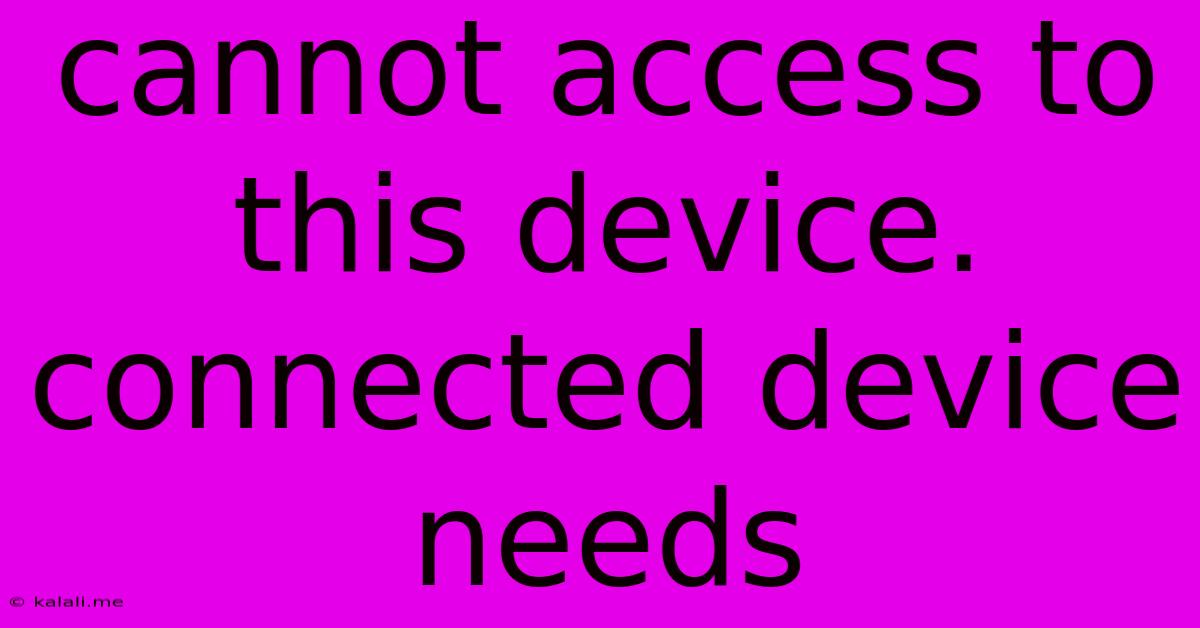Cannot Access To This Device. Connected Device Needs
Kalali
Jun 05, 2025 · 3 min read

Table of Contents
Cannot Access This Device: Troubleshooting Connected Device Issues
Are you facing the frustrating "Cannot access this device" error message when trying to connect to a peripheral, like a printer, external hard drive, or USB device? This common problem can stem from several sources, and this guide will walk you through troubleshooting steps to get your device working again. We'll cover everything from simple checks to more advanced solutions, helping you regain access to your data and peripherals.
Understanding the Error Message
The "Cannot access this device" error is a generic message, meaning the underlying cause could be varied. It often indicates a problem with the device's connection, drivers, or permissions. Before jumping into troubleshooting, understanding the context is crucial. Note the specific device and where you're encountering the error (e.g., File Explorer, a specific application).
Common Causes and Solutions:
Here's a breakdown of frequent causes and their corresponding solutions:
1. Connection Problems
- Loose Connections: The most obvious culprit! Carefully check all cables connecting your device to your computer. Ensure they are securely plugged into both ends. Try different ports if available. Sometimes, a slightly loose connection can cause intermittent issues.
- Faulty Cables: If the problem persists, try a different cable. A damaged cable can prevent proper communication between your device and your computer.
- Power Issues: If your device requires external power (like an external hard drive), ensure it's properly plugged in and receiving power. Check the power adapter and outlet.
2. Driver Issues
Outdated, corrupted, or missing drivers are a significant cause of connectivity problems.
- Update Drivers: Go to your device manager (search for "Device Manager" in the Windows search bar). Locate your device, right-click it, and select "Update driver." Choose "Search automatically for drivers" and let Windows find the latest version. If this doesn't work, try manually downloading the latest driver from the manufacturer's website.
- Reinstall Drivers: If updating doesn't work, try uninstalling and reinstalling the driver. In the Device Manager, right-click the device, select "Uninstall device," and then restart your computer. Windows will usually automatically reinstall the driver.
- Check for Driver Conflicts: Sometimes, driver conflicts can prevent a device from working correctly. Try updating or uninstalling other recently installed drivers to see if this resolves the issue.
3. Permissions and Access Rights
- Administrative Privileges: Some devices may require administrative privileges to access. Try running the application or accessing the device with administrator rights.
- User Account Control (UAC): Ensure your UAC settings aren't overly restrictive. Temporarily lowering the UAC setting might allow access (though this should be done cautiously).
- File System Permissions: If you're accessing a shared drive or folder, check the file system permissions to ensure your user account has the necessary read and write access.
4. Hardware Issues
- Device Failure: Unfortunately, the device itself might be malfunctioning. If none of the above steps work, the device might need repair or replacement.
- Port Failure: It's possible the USB port on your computer is faulty. Try connecting the device to a different USB port.
5. System File Corruption
In rare cases, corrupted system files can interfere with device access. Consider running a System File Checker (SFC) scan to repair any corrupted system files. (Search for "Command Prompt" in Windows, right-click, select "Run as administrator," then type sfc /scannow and press Enter).
Prevention Tips:
- Regular Driver Updates: Keep your drivers up-to-date to avoid compatibility issues.
- Proper Cable Management: Avoid bending or damaging cables.
- Regular System Maintenance: Perform regular system maintenance, including disk cleanup and defragmentation, to improve system stability.
By systematically checking these points, you should be able to resolve most "Cannot access this device" errors. If the problem persists after trying these troubleshooting steps, consulting a computer technician might be necessary. Remember to document the specific error messages and details about your device and setup to help in troubleshooting.
Latest Posts
Latest Posts
-
Mac Delete Folder In Libraray Operation Not Permitted
Jun 06, 2025
-
When Does Rimuru Become A Human
Jun 06, 2025
-
What Does It Mean When Someone Says Beas
Jun 06, 2025
-
Does Super Glue Work On Plastic
Jun 06, 2025
-
Is It Me Neither Or Me Either
Jun 06, 2025
Related Post
Thank you for visiting our website which covers about Cannot Access To This Device. Connected Device Needs . We hope the information provided has been useful to you. Feel free to contact us if you have any questions or need further assistance. See you next time and don't miss to bookmark.